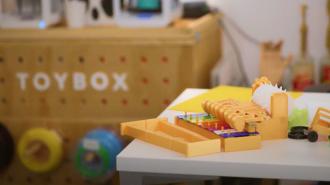Toybox aims to bring an almost magically simple experience to kids: With the press of a button, a small machine will print nearly any toy imaginable, all in their own home. But to the founders of the company, building and selling such an easy-to-use 3D printer was anything but simple.
The team did start off with a couple key advantages: backgrounds in the tech industry and experience in using 3D printers. Even to them, using 3D-printing technology was far from simple.
“We were building all types of stuff, but the learning curve was very steep.”
Ben Baltes, Toybox CEO and co-founder
Building more accessible 3D printers became the goal for Baltes and Toybox co-founders Jenn Chinn and Zach Oligschlaeger. But before starting the company, the team wasn’t sure which types of objects they wanted to produce with 3D printers. A 3D printer can make everything from medical devices to flutes to camera lenses, representing an industry worth more than $13 billion.
“We wanted to find a market that made a lot of sense, and we looked at a ton of markets,” Baltes told Freethink. “There’s tons of things around the house that you can print, but we wanted to start with something that people would find use out of right away. And for us that was toys.”
The toy that builds toys
Toys are a good match for consumer-grade 3D printers. Although industrial 3D printers can produce a small house in about 24 hours, hobbyist printers like Toybox print more slowly, and the smaller size of the device limits the range of producible objects.
Simple toys fall in the sweet spot. To build them, Toybox works like other 3D printers: stock the printer with filament, connect it to a computer, choose a design, and it can print objects within minutes to a few hours, depending on the complexity of the design.
What makes ToxBoy unique isn’t necessarily its hardware, but rather its ease of use and the company’s software, which includes an online catalog of free and customizable toy designs: animal figurines, castles, miniature cars, whistles, ninja stars, and fidget spinners, to name a few. Users can also create and upload their own toy designs for others to download, and the device can print designs from outside of the Toybox network.
Today, the simplicity of Toybox and its wide variety of toy designs are helping the company earn millions in revenue. But that success came only after multiple close calls with failure.
On the brink of failure
In 2016, Toybox introduced one of its early prototypes to attendees at San Francisco’s Maker Faire, a convention where do-it-yourself makers present their creations and products. Baltes felt confident going into the convention. But after seeing all the other sleek creations on display, the team realized that their spray-painted prototype needed some upgrades in order to appeal to a wider commercial market.
The children at the convention didn’t seem to mind the prototype’s unpolished look. They were more interested in seeing a toy get built before their eyes. By the end of the convention, the Toybox team had 3D printed about 600 toys for kids in attendance, showing promise that there could be big demand for Toybox printers if the company could manage to scale up.
“The kids, they were the ones that really proved we’re onto something here.”
Jenn Chinn
But scaling up would require money. As they continued to innovate the product, Baltes and his team went about two years without paying themselves, eventually hitting the point where the CEO had to dip into his retirement savings to keep the company afloat. Part of the problem was miscalibrated pricing.
Toybox began offering its printer for about $400. Despite most would-be customers thinking that such a device would be more expensive, few were willing to buy it at that price. After lowering the price to $200, more customers started buying, though that price point was too cheap to be sustainable. The team ultimately landed on $300.
Sales were increasing but not quickly enough. A private fundraising round, followed by an Indiegogo campaign, helped boost sales higher. Then came the company’s big break: an appearance on Shark Tank, which ended with the company securing a $150,000 investment deal in exchange for equity and advisory shares.
The publicity caused a surge in Toybox sales.
“We sold out almost immediately,” Baltes told Freethink. “That made a huge difference for us.”
Bigger companies took note. In 2021, Toybox and Warner Bros. announced a licensing agreement that enabled Toybox to add to its design catalog iconic characters from brands like DC Comics, Looney Tunes, Cartoon Network, and Hanna-Barbera. The deal is one factor, combined with fundraising, an innovative product, and increased publicity, that’s helped Toybox’s annual revenue grow from $160,000 to $10.6 million.
More broadly, 3D printing is a rapidly growing industry. Although the technology dates back to the 1980s, at-home 3D printers only started becoming affordable in the past decade. Today, most hobbyist models cost between $200 to $500, while more advanced at-home models easily exceed $1,000. 3D printing culture is growing, too: Users can design and produce just about anything that the size of the device and the thermoplastic filament will allow.
Toybox is continuing to focus on its key demographic: children and families seeking an easy way to explore this emerging field. Despite flirtations with failure, the company’s decision to go all in on their targeted niche has been paying dividends.
“Most success arcs have periods where the founders think they’re going to fail and push through it,” Baltes said. “I think what differentiates, you know, the successful people are the people who don’t give up. And a little bit of luck.”






